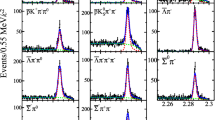Abstract.
The product branching ratio, \(f ({\rm b} \to \Lambda_{\rm b}) \cdot{\rm BR} (\Lambda_{\rm b} \to \Lambda{\rm X})\), where \(\Lambda_{\rm b}\) denotes any weakly-decaying b–baryon, has been measured using the OPAL detector at LEP. \(\Lambda_{\rm b}\)'s are selected by the presence of energetic \(\Lambda\) particles in bottom events tagged by the presence of displaced secondary vertices. A fit to the momenta of the \(\Lambda\) particles separates signal from B meson and fragmentation backgrounds. The measured product branching ratio is \[ f ({\rm b} \to \Lambda_{\rm b}) \cdot{\rm BR} (\Lambda_{\rm b} \to \Lambda{\rm X}) = (2.67) \pm 0.38 ({\rm stat})^{+0.67}_{-0.60} ({\rm sys}))\%\; . \] Combined with a previous OPAL measurement, one obtains \[ f ({\rm b} \to \Lambda_{\bf b}) \cdot{\rm BR} (\Lambda_{\rm b} \to \Lambda{\rm X}) = (3.50) \pm 0.32 ({\rm stat})\pm 0.35 ({\rm sys}))\%\; . \]
Similar content being viewed by others
Author information
Authors and Affiliations
Consortia
Additional information
Received: 25 November 1998 / Published online: 27 April 1999
Rights and permissions
About this article
Cite this article
The OPAL Collaboration., Abbiendi et al., G. A measurement of the product branching ratio \(f ({\rm b} \to \Lambda_{\rm b}) \cdot{\rm BR} (\Lambda_{\rm b} \to \Lambda {\rm X})\) in \({\rm Z}^0\) decays. Eur. Phys. J. C 9, 1–9 (1999). https://doi.org/10.1007/s100530050388
Issue Date:
DOI: https://doi.org/10.1007/s100530050388




